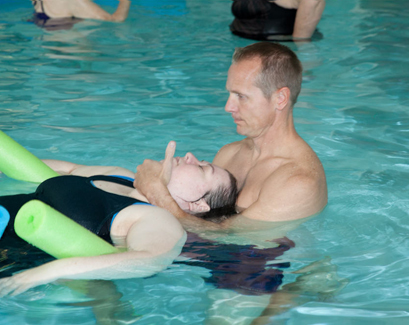What is Aquatic Therapy and Who Is It For?
Aquatic physical therapy (APT), also known as water therapy, or aquatic therapy is a form of physical therapy that is performed in the water by a licensed physical therapist. According to the National Rehabilitation Information Center (https://www.naric.com/?q=en/FAQ/what-is-aquatic-therapy), water therapy is used for “treatment, rehabilitation, prevention, health, wellness, and fitness of the patient/client population in an aquatic environment with or without the use of assistive, adaptive, orthotic, protective, or supportive devices and equipment.
What are the Benefits of APT:
One of the reasons why aquatic therapy is so beneficial is because it uses the patient’s body weight and the resistance of the water to help them get stronger. Therefore, patients are at less of a risk of injuring themselves than if they participated in a regular physical therapy program on land. Since the water is a natural form of resistance, clients become stronger and are in an environment where they can heal quickly. Some of this is because part of the APT program targets the patients breathing technique, as well as includes massage therapy, which promotes relaxation and increases circulation in the body. When a person is relaxed, their muscles are warmed-up and are ready to do some exercises.
Mercer County Community College,states that “Aquatic therapy utilizes hydrostatic pressure to decrease swelling and improve joint position awareness…This pressure provides joint positional awareness to the patient. This is extremely important for patients because it helps them become “in tune” with their bodies. This awareness helps them know what proper joint movement should feel like and how proper positions feel like. For example, if a patient suffers from low back pain, the chances are that their body becomes accustomed to the pain and compensates for it. Water therapy will not only relax those muscles but will also strengthen them, which will provide proper alignment, thus, reducing pain for that person.
Other advantages of aquatic therapy are:
- Resistance to improve balance
- Less impact on the joints
- Less chance of falling and causing further injury
- Increased joint flexibility
What is it like in the therapeutic water pools?
There are a few different types of aquatic pools. Some only provide warm water, while others have cool water. Warm water therapy is ideal for increasing flexibility, reducing swelling, improving circulation, relaxing muscles, and it warms the muscles for exercise. On the other hand, cool water therapy is excellent for reducing joint inflammation, and it reduces the recovery time for some patients. Some pools have temperature controls and can change the temperature from warm to cool or vice versa.
Other therapeutic pools have massage jets. The jets are an excellent way to “cool down” from therapy because they prevent the lactic acid from building up in your muscles.
Did you know that there are even therapeutic aquatic pools with adjustable floors and water levels? The adjustable floor is ideal for patients who have trouble climbing the stairs in the pool or have difficulty balancing themselves. The adjustable water level feature is fantastic for patients who have built up their strength and don’t need as much resistance from the water in the pool. When the therapist lowers the amount of water in the pool, it can be used to transition the patient from APT to traditional physical therapy on land.
The use of these kinds of pools allows the physical therapist to accommodate their patients and create a individualized exercise plan for them.
Aquatic therapy is a unique kind of physical therapy that is suitable for people of all ages and all fitness levels. Water therapy also helps those who suffer from different ailments, such as Parkinson’s Disease, stroke, arthritis, lower back pain, problems with balance, and even depression. Additionally, aquatic therapy helps patients who are recuperating from surgery, as well as children with disabilities, such as Multiple Sclerosis or Autism.


